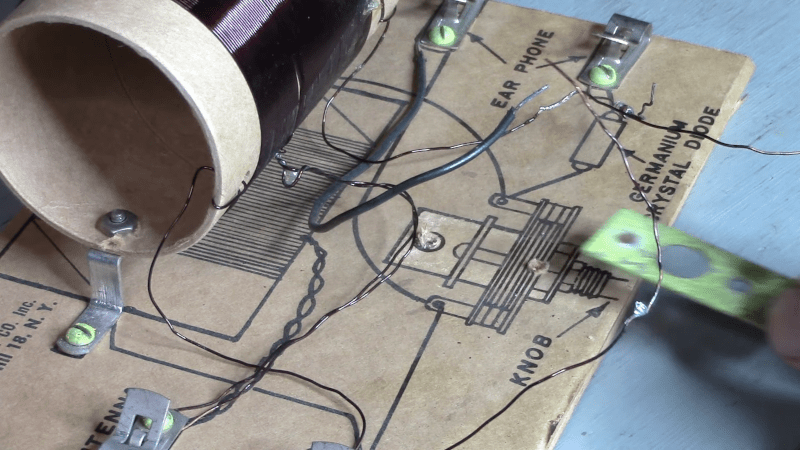The classic crystal radio was an oatmeal box with some wire and a few parts. [Michael Simpson] has something very different. He found an assembled Philmore “selective” radio kit. The simple kit had a coil, a germanium diode, and a crystal earphone.
We were sad when [Michael] accidentally burned a part of the radio’s coil. But–well–in the end, it all worked out. We’ll just say that and let you watch for yourself. The radio is simplicity itself, built on a wooden substrate with a very basic coil and capacitor tuned circuit.
The model VC-1000 appears to be about 60 years old, and back then, it cost $5. That doesn’t sound like much, but that’s about $50 in today’s money. Of course, a nice one in mint condition today would probably be worth a good bit more than $50.
[Michael] uses an amplifier to let us listen in, but the original crystal earphone has to have a high impedance to prevent loading the detector. At first, there was an intermittent connection to the radio, perhaps not surprising after 60 years for a $5 radio.
The variable capacitor had metal plates with what looked like mylar spacers. The capacitor plates intermittently shorted, probably due to damage to the spacers. He did take the cap apart and found the root cause of the issue. Watching him reassemble it was oddly calming.
A “new” capacitor finally arrived. After a little surgery, the radio was back to its original condition. It always seems like magic that just some wire, metal plates, and a little glass-like cylinder is all you need to hear signals that fly through the air.
While crystal radios tend to be simple, that’s not always true. They can also be a lot smaller.















The first thing I recall hearing on my Philmore crystal set was a news report on the day Roger Bannister broke the four-minute mile. None of that fancy 1N34A stuff, it had a cats whisker and an actual crystal. The antenna was strung from my 2nd floor bedroom to the roof of the outhouse, and the high impedance headphones were plenty loud.
The first thing I did hear on my modified AM radio (I just did wind some turns of wire around the ferrite antenna inside the case and the other side of the wire went as far away as I could up to a tree) was a beautiful Chinese voice from Radio Taiwan International, her name was Elena Cheng, teaching Chinese. It. For a kid like I was, that was like a dream.
A few years back, I stopped at a garage sale on a whim and, for a buck, I walked away with an un-assembled Boy Scout Radio Kit. It’s similar in some regards to this kit: You build it on a cardboard base, and features a hand-wound coil. The design here has no tuning cap (it tunes with a slider on the coil) but it does feature a real galena crystal and cat’s whisker, as opposed to a packaged diode.
Here’s an example of one at radiomuseum.org if you want details:
https://www.radiomuseum.org/r/nationalsu_cub_scout_radio_kit.html
It’s possible to pickup FM with this passive of a setup. Slope detection a diode and a very selective cavity filter made out of stove duct and a garbage can. That is all that’s left when AM goes dark.
Well, communities could build their own AM transmitters anytime after an catastrope.
Existing car radios or kitchen radios in the town or village would still be able to pick up signals from such a local lower power radio station.
It’s such a simple a circuit had been described in the electronic construction kit I had when I was little.
The manual warned though, that it wasn’t being allowed to be used in my country.
Google is your friend.
https://electronbunker.ca/eb/FMCrystalSet.html
I remember my older brother had one like this around the early 60s except his had a solar cell to power it.
60s? That was probably selenium one- nice memories.
radio is not problem
the problem is getting headphones or converting the buzzer for such headphones
That’s great capacitor rebuilding music! I had this kit in the late 1960s and it worked beautifully with my 50 ft outdoor antenna. I loved that Ivory colored knob!